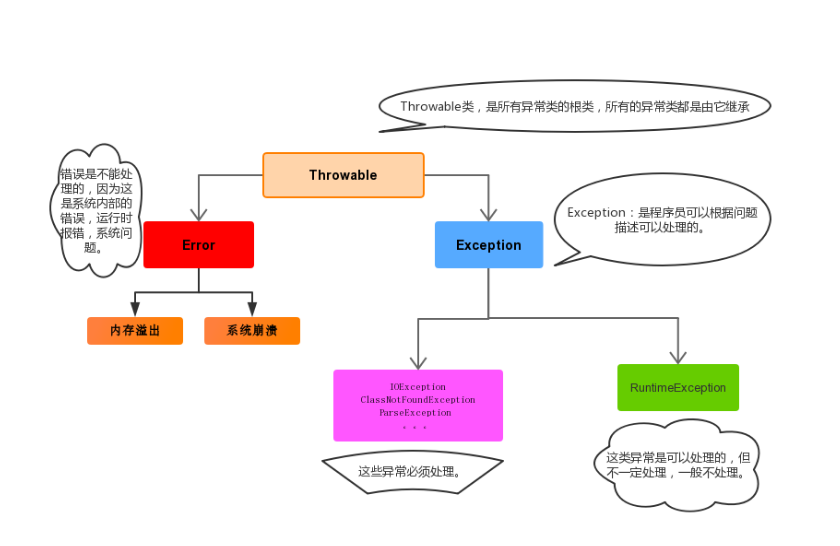Java基础学习(七) – 异常处理
- 2019 年 10 月 12 日
- 筆記
1.异常概念
异常指的是程序在执行过程中出现的非正常的情况,导致JVM的非正常停止。在Java中,异常是一个类,产生异常就是创建异常对象并抛出一个异常对象。
异常指的并不是语法错误,语法错误,编译不会通过,而是编译通过后,程序执行异常。
异常的作用是帮助我们找到程序中的问题。
2.异常产生过程解析
public class TestException { public static void main(String[] args){ int[] arr = {1,2,3}; System.out.println(arr[3]); } }

运行过程解析:
- 在 arr 数组中提取索引 3,由于数组没有索引3,导致了运行异常,JVM对这个异常做了识别,并抛出异常给 main 方法。
- 由于 main 方法并没有异常处理,main 方法又把异常返回给 JVM。
- JVM 收到异常后,打印异常详细信息到控制台,同时中断程序。
3.异常类
java.lang.Throwable 是异常的根类。
Throwable 体系:
- java.lang.Error:严重错误,不在我们处理范围内。
- java.lang.Exception:平时所说的异常是此类。我们可以通过修改代码纠正错误,使程序能正常运行。异常又分为checked异常(编译异常)和runtime异常(运行异常)。
Throwable 常用方法:
- public void printStackTrace():打印异常的详细信息。
- public String getMessage():获取异常发生的原因。

4.异常处理
Java 异常处理的五个关键字: try、catch、finally、throw、throws。
- throw 抛出异常。
- throws 声明异常。
- try…catch…finally 捕获异常。
throw:
public class TestException { public static void main(String[] args){ int[] arr = {1,2,3}; int index = 3; if (index < 0 || index > arr.length -1){ throw new ArrayIndexOutOfBoundsException("数组越界"); } System.out.println(arr[index]); } }
throws 用于方法声明之上,表示当前方法不处理异常,并提醒该方法的调用者来处理异常。
若该方法可能有多种异常情况产生,那么在throws后面可以写多个异常类,用逗号隔开。
public class TestException { public static void getIndex(int index) throws ArrayIndexOutOfBoundsException{ int[] arr = {1,2,3}; if (index < 0 || index > arr.length -1){ throw new ArrayIndexOutOfBoundsException("数组越界"); } } public static void main(String[] args) throws ArrayIndexOutOfBoundsException{ getIndex(4); } }
public class TestException { public static void main(String[] args){ int[] arr = {1,2,3}; //捕获数组越界异常 try{ System.out.println(arr[4]); }catch (ArrayIndexOutOfBoundsException e){ e.printStackTrace();//获取异常详细信息 }finally{
System.out.println("程序继续执行");
} //继续执行 System.out.println(arr[2]); } }
可以写多个catch 捕获多个异常。需要注意的是catch捕获异常不能相同,异常子类一般要写在异常父类上面,否则异常被父类捕获,子类无法捕获详细异常。
在继承关系当中,如果父类抛出异常,那么子类重写父类方法时,抛出和父类相同的异常或者不抛出异常。如果父类没有抛出异常,子类重写父类该方法时也不可抛出异常,若该子类方法产生异常,只能捕获不能声明抛出。
//自定义异常类 class CustomException extends Exception{ //无参构造方法 public CustomException(){}; //有参 public CustomException(String msg){ super(msg);//继承Exception 构造方法 } } //测试 public class TestCustomException { public static void main(String[] args){ int[] arr = {1,2,3}; int index = 3; try{ if (index<0 || index>arr.length-1){ throw new CustomException("数组越界"); } }catch (CustomException e){ e.printStackTrace(); } } }

温馨提示
- 如果您对本文有疑问,请在评论部分留言,我会在最短时间回复。
- 如果本文帮助了您,也请评论关注,作为对我的一份鼓励。
- 如果您感觉我写的有问题,也请批评指正,我会尽量修改。
